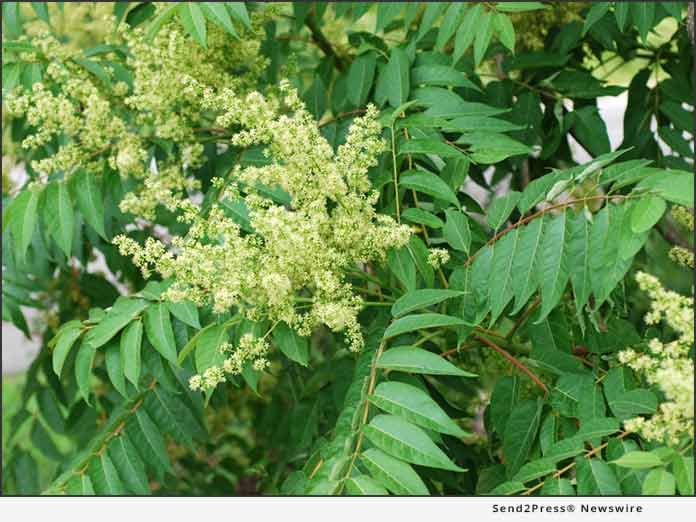
HUNTINGDON VALLEY, Pa., Nov 18, 2019 (SEND2PRESS NEWSWIRE) — Researchers are still learning about the Spotted Lanternfly, an invasive insect attacking trees and causing property damage across Pennsylvania. Penn State, along with the PA Department of Agriculture and the USDA, has been researching the habits and life cycle of Spotted Lanternfly since it first appeared in Berks County in 2014.
One thing is certain: the Ailanthus Tree (or Tree of Heaven) is a magnet for these pests. The experts at Giroud Tree and Lawn explain why if homeowners have an Ailanthus tree on the property, removal may be the best way to avoid an invasion of Spotted Lanternfly.
Why Is Spotted Lanternfly Spreading So Fast?
Spotted Lanternfly came from Asia, where natural predators keep the species from multiplying too quickly. Unfortunately, here in the United States, it’s spreading rapidly because those known predators aren’t around to keep it in check.
What Can Homeowners Do to Control Spotted Lanternfly?
Although this insect’s population is growing exponentially each year, there are many things homeowners can do to control it:
* Use sticky bands on trees starting in early May to catch any young nymphs.
* Treat any infested trees with a basal trunk spray in July to kill adults as they crawl up the tree.
* Treat any infested trees with 1-2 foliar sprays in late August – early November to kill adults in the crown of the tree.
* Scrape and destroy all egg masses on any reachable branches and the trunk of the tree. Also check for egg masses on the undersides of every surface outside, including playsets, grills, decking, railings, patio furniture and siding.
* Remove all Ailanthus trees and Ailanthus tree sprouts from the property.
What is an Ailanthus Tree?
The main host tree for Spotted Lanternfly is the Ailanthus Altissima, or Tree of Heaven. Ailanthus trees came to the U.S. from China around the 1780’s. Classified as “weed trees”, they reproduce by both seed and root sprouts. Shoots can sprout from the tree’s roots from as far away as 5o feet around the tree!
Ailanthus trees can grow up to 100 feet tall and the trunk can be nearly 6 feet in diameter. They have a great canopy and often thrive easily in conditions other trees don’t. In fact, an Ailanthus tree may be viewed as an important part of the yard and homeowners may be hesitant to remove them. However, if there are any other valuable trees on the property, the Ailanthus will attract Spotted Lanternfly and the insects could also swarm other trees.
Spotted Lanternfly have been known to attack other types of trees, including Black Walnuts, Maples, Birches, Willows, and many more. According to the PA Department of Agriculture, they feed from more than 70 species of trees, and 25 of them are found in Pennsylvania. Keeping an Ailanthus tree is like inviting Spotted Lanternfly to a buffet in the backyard!
How to Remove Ailanthus Trees
If homeowners have an Ailanthus tree or are not sure if a tree is an Ailanthus, they should call an ISA Certified Arborist to evaluate the tree look for signs of Spotted Lanternfly. Giroud Tree and Lawn recommends removing Ailanthus trees and grinding the stumps down as deeply as possible.
After removing the Ailanthus tree and stump, sprouts may still pop up on the property. The good news is they are easy to remove! Grab the shoot by its base and pull upward gently to remove the young tree and all of its roots. To see how to identify and remove an Ailanthus tree, watch this video with Giroud Tree and Lawn’s ISA Certified Arborist, Mike Chenail.
About Giroud Tree and Lawn
Giroud Tree and Lawn specializes in tree service, lawn care and mosquito and tick control programs that make customers love doing business with the company since 1974. Serving Bucks, Montgomery and Philadelphia Counties, the company offers professional tree and lawn evaluation, tree pruning, tree removal, insect and disease control, fertilizing, stump removal, traditional and 100% organic lawn programs and mosquito and tick control. Giroud Arborists are certified by the International Society of Arboriculture (ISA) and have the knowledge and experience required to properly diagnose, treat and maintain trees and lawn health. The company is Accredited by the Tree Care Industry Association and Better Business Bureau. Giroud has also been awarded the Angie’s List Super Service Award(r) every year since 2005. The “Giroud Treework for Charity” program donates free tree care services to parks, historical sites and other non-profit organizations located in the Company’s service area.
For more information, visit the company website at http://www.giroudtree.com or call 215-682-7704.
News Source: Giroud Tree and Lawn
Related link: http://www.giroudtree.com
This press release was issued on behalf of the news source, who is solely responsible for its accuracy, by Send2Press Newswire. To view the original story, visit: https://www.send2press.com/wire/giroud-tree-and-lawn-explains-homeowners-should-remove-ailanthus-trees-the-host-plant-for-spotted-lanternfly/






